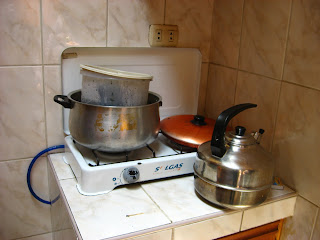
Here's the new recipe:
Natural Indigo Fructose Dye
Needed: 1kg rotten/over-ripe fruit
3gal bucket with a snug lid
10g natural reduced indigo
Mortar and pestle
6g Calx/ slaked lime
A stove and a tea kettle and a pot or two
Cutting board and knife
Gram scale
Nitrile gloves
Dust mask
Thermometer
Stir stick (pref. wood)
Protein Fibers (yarn, fabric, ect) in aprox. 15g quantities to begin…
Two notes before I begin:
-First, always put the lid on your bucket between steps, to reduce the amount of oxygen that is allowed access to the vat.
-Second, always pour your liquids gently, tipping the bucket and pouring down the side to prevent the addition of oxygen to the vat.
1. Crush or very finely chop the 1kg fruit. The riper the fruit the better. Add to pot with a very small amount of water (1/4c aprox) and boil no more than 20min.
2. Put on a tea kettle for boiling hot water.
3. Add entire pot to your 3gal bucket and add hot water until the bucket is just
slightly less than half full.
4. Weigh out your 10g indigo and grind it until it’s an even, extremely fine consistency. Make sure you’re wearing a dust mask as the particulates can act as inhalants and irritate your throat.
5. Add hot water to your indigo in the mortar and pestle and grind again until all the indigo has dissolved.
6. Add dissolved indigo to your fructose vat and stir with the pestle to get all the indigo off it.
7. Measure Calx (6g) and add immediately to your vat. **remember to wear gloves and measure it in a place with good air circulation
8. Stir the calx quickly into your vat. The liquid will turn a dark olive green. If no bubbles form, add another 4-6g Calx to the vat and stir quickly again. You are looking for surface bubbles and a bronze skin that forms on the surface.

9. Let sit 10 minutes before skimming the film and bubbles off the surface.
10. Wet your yarn and wring out completely before adding to the vat. Add it slowly, using your stir stick to gently press under the surface of the indigo liquid.
11. Leave yarn sit 20min.
12. Remove the yarn gently (no bubbles) after 20min and rinse well.
13. Shake the yarn to expose it to oxygen, until all green color has left it.

14. Hang to dry 30min

15. If the yarn is not dark enough, you can re-dip it after your 30min is up.
To do consecutive vats:

1. Heat the pot of water to boiling and add the vat to it once it’s hot. (like a double boiler)
2. Leave vat in pot until the temperature reaches 50 degrees C/F??
3. Add more yarn, same as above. Leave sit 30 min before removing and rinsing. Shake as before to expose to oxygen, and hang dry.
**After you are finished dyeing, you must leave your fabric/yarn alone for 2 weeks before using!!

No comments:
Post a Comment